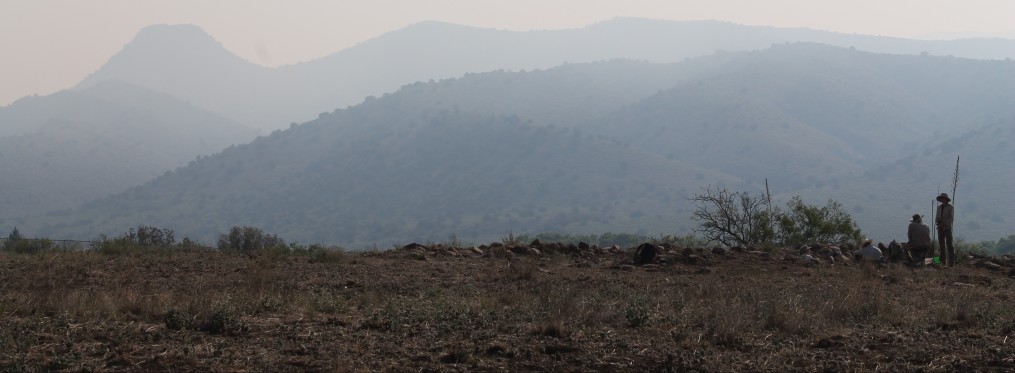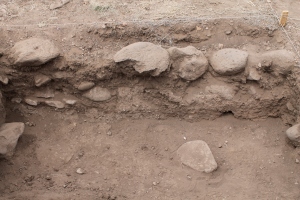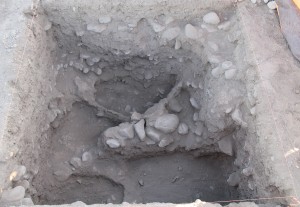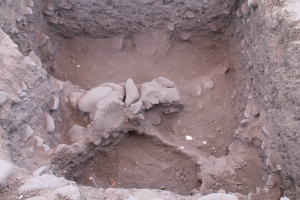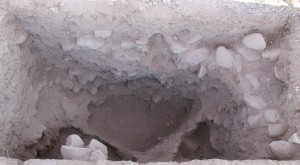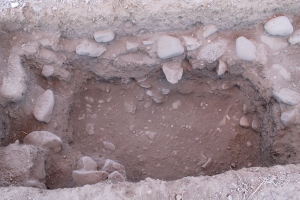*I’ve uploaded a picture of the adobe mixing pit mentioned in Unit 4.
6/16/12
As expected, most of what I thought about the units currently open at Woodrow Ruin at the end of yesterday went out the window first thing this morning. If anything, this blog will be fun to read through once the project is done, to see how my thinking about the site changed on a day to day basis, but this is normal in the life of an archaeologist. Today was perhaps the busiest day at the site yet in terms of the pace we discovered new features. I hardly noticed the clock tick from 6:30 am to 2:30 pm.
Unit 2. One of the earliest discoveries of the day was that Unit 2 in fact was not coming down on rooffall. I now think the hard material was a very informal surface. Artifact density decreased dramatically almost immediately once excavations began. Only a few centimeters below the hard material we came across sterile soil. Thus, it seems like we have finally reached the bottom of Unit 2. Although we reached sterile, the unit gave us one final surprise. The fill immediately south of the metate mentioned yesterday was softer, less rocky, and lighter in color than the sterile soil that surrounded it. I therefore excavated this soil as a feature (which was a thrill for me, as I have little time to actually dig as a project director). The pit was apx 50 centimeters wide and 24 centimeters deep. Unfortunately it was not filled with ash, or any other “cool” material, and it can best be described as a “pit of ambiguous function”. However, it undoubtedly was a cultural, not natural, construction. The pit was lined with several small-medium sized rocks. It could have been used for storage, but if so, it was emptied out once people stopped using it. To me, it looked very similar to post holes we saw at the Harris Site on Wednesday. If it is a posthole, it most certainly was not associated with the later Classic roomblock, since there is no evidence of a post hole being dug in the east profile of the unit (which the pit is against). I would like the pit to be a post hole, but it most likely wasn’t (Update: after thumbing through a few site reports, I know think it was a posthole). Still, it was exciting to dig a feature at the site!

Pit Feature along East Wall of Unit 2
-The excavation of Unit 2 is now almost complete. I am having the crew cut back and even out the baulk in the western portion of the unit before we finish excavation. We will leave a large portion of the baulk, however, in order to help preserve the site, and also in case we are able to get archaeomagnetic data from it. R
emember, excavation of the baulk was halted when much ash and burned material was found on it. The crew has collected several flotation samples from the section they are removing, which will hopefully yield good botanical data. Finally, cutting back thisbaulk a bit will provide a very nice profile face, which will help us better understand the occupation history of the roomblock.

Western Baulk Being Cleared in Unit 2
Unit 4. In the early part of the morning the floor of Unit 4 was cleaned, mapped, and documented. As I stated yesterday, this is undoubtedly the nicest surface we have seen at Woodrow yet! And after cleaning, we identified what appeared to be two small post holes, which run alongside the adobe wall in the unit. Once all of the documentation and photographing was completed, we put another test window into the unit, to see what was beneath the floor. Only a few centimeters down, we encountered sterile sediment. Thus, we decided to cease excavations in the western part of Unit 4. We then began working on the small eastern portion of the unit. Here, we encountered another pit feature (photos of this coming tomorrow). This pit was also undoubtedly made by humans, and is lined with adobe. Like the pit in Unit 2 however, we found almost no artifacts in the unit. Thus, if it was a storage pit, it too was emptied out. To me, the pit seems like it may be an adobe mixing pit. It is immediately outside of the room identified in Unit 4. Most interestingly, the adobe lining seems to “slop” north. It almost looks like someone had repeatedly scooped something out of it. Tonight, I will read some site reports to see what previously identified adobe mixing pits look like, and hopefully determine more precisely what this feature is (Update: just checked, and it does look like an adobe mixing pit!). Tomorrow we will expand the unit to chase the adobe wall, and hopefully encounter more floor.

Small posthole?

Adobe Mixing Pit
Unit 5. Unit 5 provided the most intrigue today (along with the coolest artifacts. I know, the saying goes: “It’s not what you find, but what you find out”, but finding cool stuff always makes the day more enjoyable). The day started with the crew exploring the thin adobe alignment noticed at the end of yesterday. It immediately became clear that while the adobe is very thin, it did continue down, and met up with another thin line of adobe running perpendicular to it. We also noticed a difference in fill on either side of this adobe line. The fill on the west side (interior) was soft and loaded with artifacts, while the east side (exterior) contained many larger cobbles. Thus, it seemed like we had some sort of storage bin in the unit. By the end of the day, we had found more adobe aligning with the bin, and now think it may be architectural.

Bin/architecture at bottom of Unit 5
Yesterday I had mentioned that we found a worked sherd immediately below an ash deposit. The bin is directly below this deposit, and today we found multiple more worked sherds in the immediate vicinity. This is very exciting! We now have too many worked sherds for a simple coincidence (as a famous archaeologist once said, “There are no coincidences”). We may be coming down in some sort of workshop/activity area for making worked sherds. We not only have broken worked sherds, but sherds that also seem to have been in the process of being rounded into pendants, spindle-whorls, and other objects. Discovering this alone would have made today very successful for Unit 5. However, we also found another great artifact. Unit 5 undoubtedly contains superimposed architecture. This makes working in a 1 x 2 meter unit very difficult. We had left a baulk in the west wall, but working around this has become much too difficult. Thus, we decided to remove it. While clearing the wall, we came across a complete half of a deer mandible! This is by far the largest and most complete faunal remain we have found at the site yet! We initially thought we were outside of a structure. However, this no longer seems likely. The crew has excavated 1 meter below the surface, and is still in cultural fill. If we were extramural, we would have hit sterile soil by now. Tomorrow, the crew will continue to excavate down in the unit, hopefully defining more architecture, and making many more excellent discoveries!

Some worked sherds from Unit 5

More Worked Sherds from Unit 5

Deer/Elk Mandible from Unit 5
A very successful day at Woodrow! Along with our archaeological success, we are beginning to see the first inklings of the monsoon season. The rains are very much needed in this part of the country, and judging by the numerous large, puffy clouds we saw this afternoon, they may be coming soon!
Jakob
